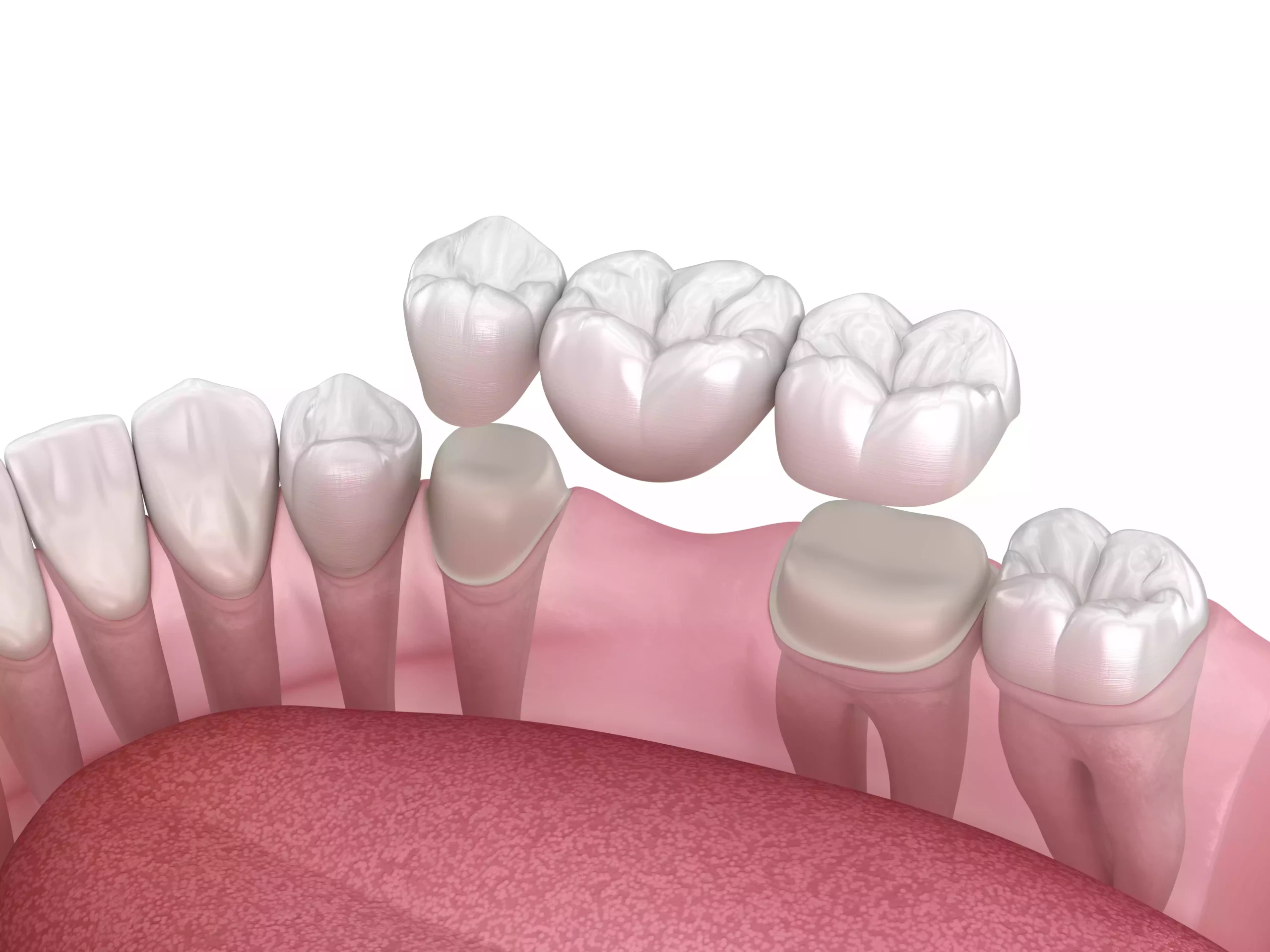Brushing after meals has long been a debated topic in dental care. Some swear by it, believing it keeps their...
Read More
Tooth loss is a problem that affects thousands of patients worldwide, and the problem of losing one or more teeth has to do with losing the smile’s aesthetics and the affectation of basic tasks such as chewing, breathing, or even speech.
Currently, in the world of dentistry, hundreds of treatments and techniques can effectively replace the loss of teeth. One of the many options patients have received well is dental bridges.
Dental bridges are dental prostheses structured and composed of crowns used to simulate the shape of one or more continuous teeth.
This prosthesis has helped patients recover part of their confidence by being able to smile using these dental bridges that, although a prosthesis, are located in specific areas of the mouth, making them go unnoticed and look like natural teeth.
It is, therefore, extremely important to know about dental bridge care, not only so that the average life span of these bridges is extended but also because this way, you can enjoy all the benefits they can offer.
This blog intends to know how dental bridge care is carried out, its advantages in the long term, and what to avoid not to affect the remaining teeth.
Understanding Dental Bridges
As previously mentioned, dental bridges are structures composed mainly of crowns used to resemble the shape of one or more teeth. The bridge is usually fixed using cement on the patient’s natural teeth.
This does not mean that all dental bridges are made the same way, as there are different ways to make this placement. The most common examples are:
Traditional: One or more dental prostheses are attached, employing crowns to the teeth connected to the lost tooth. It is the most popular type of dental bridge and with better results. It is placed when healthy teeth are on both sides of the gap.
Cantilever: It is similar to traditional bridges but is supported only on a healthy tooth.
Maryland: This is also currently a favorite option for patients. This type of prosthesis is attached with a metal or porcelain framework to the back of the teeth adjacent to the missing tooth. For this procedure, it is not necessary to grind down healthy teeth.
There is no single type of prosthesis that outperforms the others, as they all serve their main purpose equally well: replacing missing teeth and enabling essential functions like chewing food and speaking.
Dental bridge care makes those as mentioned earlier fulfilled because although dental bridges are made of a material that is very similar to the material of a natural tooth, it can also be prone to lacerations or, in the worst case, get to have some kind of infection in the gums or teeth around.
Preparing for Dental Bridge Care
The first step to having dental bridge care is to go to a dentist for a post-operative check-up, that is, to do a constant follow-up after the prosthesis has been placed.
This type of review is usually focused on seeing how the patient’s recovery has been after the placement of dental bridges to see if it has been effective or if you need to follow a series of specific instructions for the care of these.
Once you have been to the dentist, brushing your teeth after a dental bridge is an activity that should be done regularly and using the right tools.
Oral hygiene plays a very important role since it not only ensures that dental bridges do not have any type of infection but also prevents healthy natural teeth from having any type of probability of suffering any kind of dental disease, such as cavities.
Immediate Post-Placement Care
Once dental bridges have been placed, it is normal to experience discomfort or sensitivity in the area since dental bridges take a long time to adapt to the mouth. In addition, it is also necessary to take into account some dietary considerations.
It is important to follow up with the dentist for dental bridge care. If the discomfort persists, the expert’s intervention will be necessary to minimize and eradicate this type of discomfort.
Also, performing proper tooth brushing may be a little painful, especially if you do not have the proper tools; however, this does not mean that it should not be done. Some key points about dental bridge care when performing oral hygiene are:
Cepillarse los dientes mínimos dos veces al día: preferentemente en la mañana y en la noche después de cada alimento.
Complementar la limpieza con cepillos interdentales.
Usar hilo dental adecuado.
Preferentemente usar enjuague bucal solamente una vez al día, de preferencia en la noche después de cenar.
Long-Term Care for Dental Bridges
Different oral hygiene products are on the market, whether they are oriented toward dental implants, dental crowns, or dental bridge care.
These tools are indispensable for reaching areas where ordinary toothbrushes would not reach and avoiding swollen gums or discomfort in the mouth.
During this article, much emphasis has been placed on dental bridge care being care is dental check-ups with the dentist. These are not only important, but they are also necessary to know the state of the dental bridges and the mouth’s health in general since, in this way, you can prevent hundreds of diseases or make the necessary adjustments to have a proper recovery and more optimal care.
Cleaning and Maintenance
Tooth brushing for dental bridges is done with a traditional toothbrush, with the only difference being that brushing and flossing in the area of the bridge must be done very carefully, avoiding aggressively scraping the gum where the dental bridge is placed.
For good dental bridge care, oral irrigators and dental picks can be used, although it is necessary to ask a dentist how to use them correctly without hurting the dental bridges or the gums.
Eating and Drinking with Dental Bridges
There is a list of foods that should be avoided and others that should be consumed when dental bridges are placed.
For correct dental bridge care, avoiding all foods with high amounts of sulfur and sugars is necessary. These foods can affect the other teeth by causing the dental plaque on the teeth to begin to deteriorate and, therefore, the tooth is exposed to being infected by some type of disease such as cavities.
Some recommended foods to keep teeth healthy, and for dental bridge care are those foods high in calcium, such as broccoli and some dairy products. In addition, it is also necessary to consume certain types of fruits and vegetables, such as potatoes, apples, and kiwi.
Initially, it is not advisable to eat foods that are too hot or cold, much less solid food; since dental bridges are in the process of adaptation, the gums may get hurt, and the recovery may be less optimal.
Therefore, in the beginning, it is advisable to eat pureed food or soup. To switch from liquid to solid foods, it will be necessary to consult with the dentist so that they can tell you whether or not you are fit to eat normally.
Enhancing Bridge Longevity
All of the above is essential for dental bridges to have the durability they usually have on average and can make the patient chew their food as they used to, in addition to other essential activities.
Another necessary type of care to mention, in addition to the care of natural teeth, is the use of dental protectors. Whether you play sports or not, dental bridge guards are an infallible option to preserve your teeth.
At Molar House, we have a team of experts, each one of them perfectly trained in the placement of dental bridges. Our clinic has the latest in dental technology, so at all times, you can experience the feeling of security.
Come to our clinic, where you can have a completely personalized treatment and enjoy the benefits of these dental bridges by the hand of a dentist in Tijuana.
Other Posts
Veneers Maintenance Strategies for Lifelong Radiance
Veneers are a popular cosmetic dental treatment that can transform a person’s smile. However, maintaining these dental enhancements is crucial...
Read MoreLearn About the Different Types of Dental Implants
Dive into the world of dental implants and discover a range of options designed to fit your specific needs. From...
Read MoreAfter Dental Implants Care Tips You Need To Know
Are you considering dental implants or have recently undergone the procedure? Congratulations on taking steps towards a healthier, more confident...
Read MoreOur Top Services
Contact Us
Social Media





